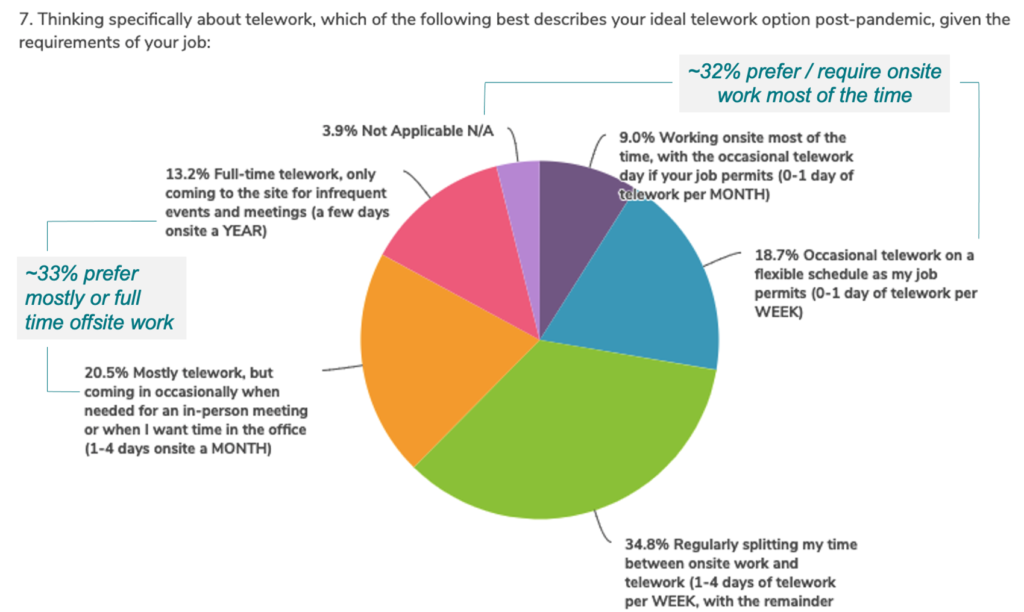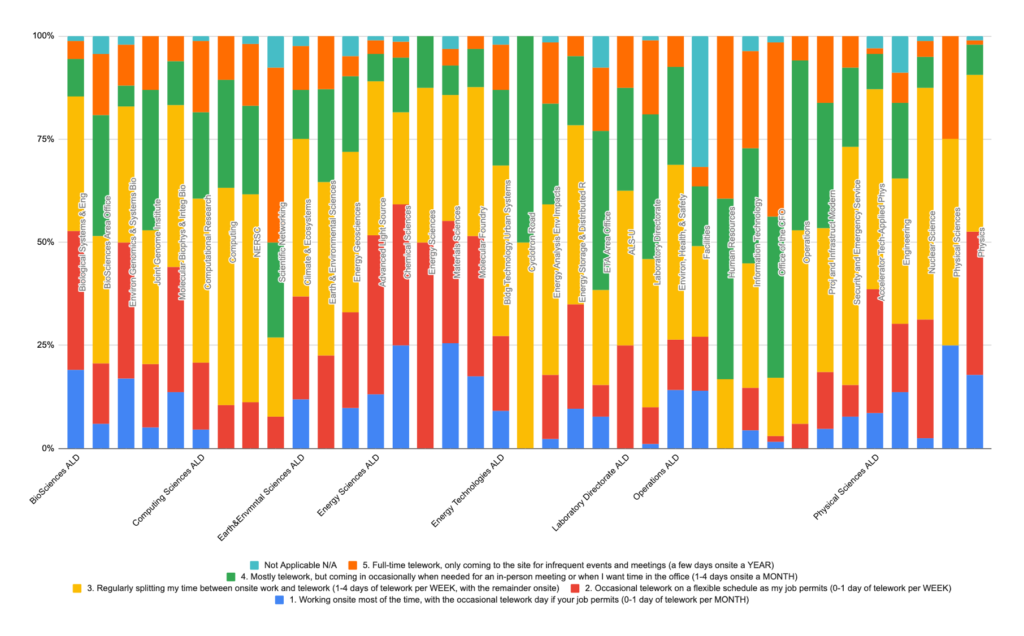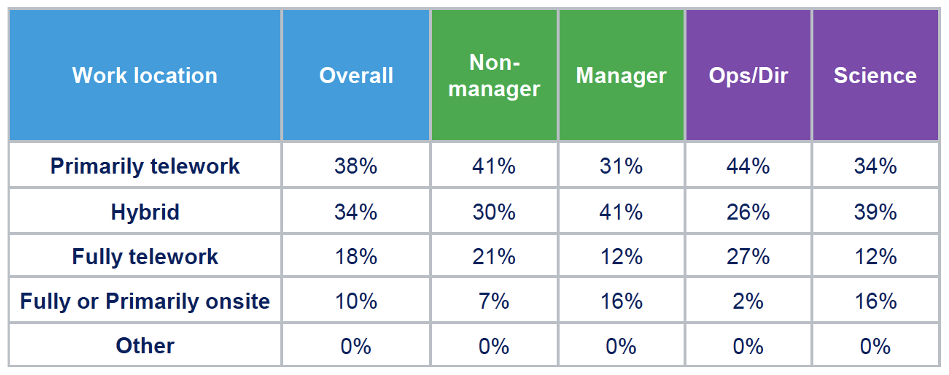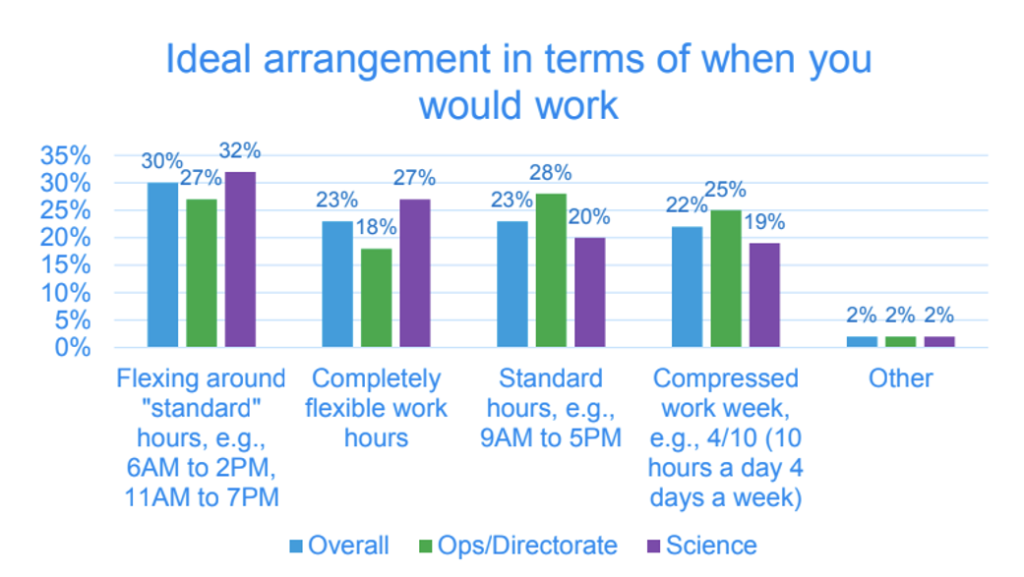Executive Summary
In January 2021, Lab leadership chartered a Future of Work Working Group (FOWG) to evaluate offsite work options for the Lab. We (the working group) held a series of staff engagements to understand how employees worked prior to and during the pandemic, and to explore post-pandemic work preferences. We considered both where Lab employees want to work and when they want to do that work. We found that mostly onsite work, mostly or fully offsite work, and a hybrid of offsite and onsite work are each preferred by large numbers of Lab staff. These preferences informed our recommendations as well as our efforts to support approaches that accommodate each work mode. We also found that Lab staff are interested in alternative work schedules, and recommend the Lab consider exploring this idea once new work modes supporting on and offsite primary work locations have been successfully implemented.
Introduction and Scope
Prior to the pandemic, the Lab had a telework policy but this mode of work was neither universally encouraged nor broadly accepted across the Lab. However, the March 2020 shelter-in-place order forced most employees to telework; in spite of some challenges, the Lab community has largely been able to function and meet essential mission needs. Noting the success of this work mode, Lab leadership chartered a Future of Work Working Group (FOWG) to evaluate offsite work options for the Lab. With members from operations and each of the research areas, the FOWG was asked to evaluate what worked well both prior to the shelter-in-place order and during COVID-19, and propose a path forward for flexible work options in a post-pandemic world.
The scope of this group’s effort was to:
- Establish the pre-pandemic, current, and post-pandemic level of interest for flexible work locations from employees and supervisors.
- Understand the flexibility and creativity needed to work in different locations while continuing to deliver on the Lab’s mission. Assess the benefits of flexible work location options for the Lab and its employees.
- Develop a strategy to implement a flexible work approach at the Lab. This strategy includes recommendations for where people can work.
- Assess existing policies related to telework and remote work and make recommendations to leadership based on a thorough risk analysis.
- Identify the challenges a more flexible work mode approach poses to the Lab’s operating environment and culture, and identify the desired outcomes that changes will make to the Lab community in future years.
This group’s primary consideration in conducting this study was to ensure that the Lab can both meet mission needs and enable flexible work options where feasible. The FOWG also weighted the importance of geographical impacts related to telework and remote work including:
- business need;
- employee preference;
- staff management; and
- compensation, taxation, and benefits ramifications for employees and the institution.
Equity and inclusion, particularly in assuring equal access to future opportunities and mentoring early career staff, was also a key consideration. At this phase of the group’s work, the FOWG is producing a plan, including recommendations for necessary tools, technology, and training, to successfully implement new work approaches.
FOWG members:
- Michelle Lee – HR; FOWG Project Sponsor
- John Chernowski – Operations; FOWG Project Manager
- Paul Adams – BSA
- Jeff Blair, Therese Leone – Legal
- Wade Crosson – HR Policy
- Ellen Ford – Operations Directorate
- Minh Huebner – OCFO
- Lady Idos, Aditi Chakravarty – IDEA
- Susan Lucas – CSA
- Peter Nico – EESA
- Mary Ann Piette – ETA
- Andreas Scholl – ESA
- Tony Spadafora – PSA
- Adam Stone – IT
- Dianne Wentworth – Strategic Communications
Project Timeline
Beginning in February 2021 and continuing into FY22, the project has four distinct phases:
- February-March, 2021: Understand how we worked pre- and during COVID
- March-May, 2021: Engage stakeholders and identify opportunities: what’s possible, desirable, sustainable.
- May-June, 2021: Partner with Lab to shape recommendations for flexible work.
- June 2021- FY22: Develop and implement policies, processes and tools to support the future of work.
Methodology
The working group developed an online survey to gain an understanding of work prior to and during the pandemic, and to explore various post-pandemic work options. The survey was sent to paid employees of the Lab, including postdocs; by design we did not include graduate student research assistants (GSRAs) and other students. The survey had an overall participation rate of 85% with a total of 3,309 of Lab employees completing all or some of the survey. The participation rate was consistently high across all divisions, though divisions with large faculty populations were slightly underrepresented.
The working group also engaged Mercer Consulting, a firm with experience working with industry and universities, to gather additional input from employees and supervisors. Mercer conducted two virtual interactive sessions with employees, a series of leadership interviews and line management surveys. In addition, Mercer analyzed labor market trends and preferences, and information provided by Human Resources, OCFO, Facilities, and Strategic Infrastructure Planning in order to understand labor trends, and future science program and project growth at the Lab. All inputs and feedback guided FOWG’s recommendations to senior leadership.
Employee Feedback and Survey Results
The results and feedback from the above methods are organized below and considered two primary questions: Where do Lab employees want to work and when do they want to do that work?
The following data was shared with Lab leadership and informed recommendations about telework and other flexible work options.
WHERE do Lab employees want to work?

For preferred work location, overall survey results (n=3309) indicated that approximately 32% of respondents would continue to work on a Lab site most of the time (assuming to include Not Applicable), 35% prefer to regularly split time between onsite and offsite work with one to four days of telework per week, and 33% of survey respondents indicated a preference for mostly or full time offsite work.
That being said, each division presented a range of responses from 0-62% in indicating the need to work onsite most of the time with the occasional telework day if the job permits. For example, around 60% of respondents in Facilities noted telework was either not applicable or very occasional and 62% of bench researchers in Chemical Sciences indicated the need to perform work primarily on a Lab site. Click here for a larger version of the chart below.

Similar statistics were reported in the virtual interactive sessions (n=968), with 34% of respondents preferring hybrid work.

In contrast, supervisors and managers, on average, prefer to work onsite more often than their non-supervisor colleagues, with only 43% wanting to primarily or fully telework, compared to 62% of non-supervisors. Supervisors also shared that they are concerned with their own productivity and work-life balance in a hybrid teleworking model.
Both of the broad community engagements found that mostly onsite work, mostly or fully offsite work, and a hybrid of offsite and onsite work are each preferred by large numbers of Lab staff. This finding informed the working group’s recommendations and efforts to support approaches that accommodate each of these work modes, as well as a mix of all three.
WHEN do Lab employees want to work?
The internal survey and the virtual interactive sessions also asked employees’ opinions on alternative work schedules and flexible work hours. The results indicate that this is an area that the Lab should explore in the future, as the main factors driving employee preferences are related to lifestyle such as work location, work schedule, and work-life balance. And a minority of virtual interactive session participants (9%) indicated concerns related to health and safety due to the pandemic.
However, the working group recognizes that adjusting to a future of work with a large mix of routine on- and offsite work locations is a significant challenge and should take priority. The FOWG recommends that the Lab should consider exploring alternative work schedules, once the Lab has successfully implemented new work modes supporting on- and offsite primary work locations.

For work schedule, overall survey results (n=3309) indicated that nearly 78% of respondents rated flexible work hours (beginning work earlier or later) as positive or very positive, and nearly 61% noted an alternate work schedule as positive or very positive.

Virtual interactive sessions (n=968) found similar results, with the majority of employees desiring some form of flexibility in their work schedules:
- 75% indicated preference for non-standard work hours – the total of respondents for flexing around standard hours, completely flexible work hours, and a compressed work week (i.e., working 40 hours over four days instead of five).
- 23% reported preference for standard hours (e.g., 9am-5pm).
- Non-supervisors indicated a higher interest in flexing around standard hours than supervisors by seven percentage points.
Read the full results of the LBNL Future of Work survey and the full Mercer data report.
Working Group Recommendations
The working group considered the results of the internal survey, the Lab Director’s Planning Assumptions and four work modes guidance, and Mercer findings to develop the following recommendations for Lab management:
- Clearly define standard modes of work, including remote work, telework, onsite work and hybrid modes.
- Develop objective, business-need driven processes and tools that support all staff at all levels, as well as supervisor and staff discussions to determine appropriate work modes. Recognize that modes of work may change based on business needs and Lab mission.
- Implement policy, processes and tools consistently, allowing flexibility for each division to meet mission goals, and establish higher level decision-making and a resolution process in cases where management and staff disagree on work mode needs.
- Enhance and ensure equal access to career development opportunities across all work modes.
- Consider alternate compressed work schedules once flexible work modes are implemented successfully.
Implementation: What is the Lab doing now?
An implementation working group was established as a sub-committee of the FOWG to develop the policies, processes, and tools to facilitate effective implementation of flexible work modes.
In addressing Recommendation 1, this group defined the four modes of work for the future of work. These are: full time on a Lab site, hybrid, full time telework, and full time remote work.
To support Recommendation 2, this group is developing both a toolkit and process guide for supervisors and staff to use in selecting an appropriate work mode for each employee. This toolkit describes the four modes of work, important considerations for supervisors and staff, and information about allowable expenses. The process guide will provide detailed information for employees and supervisors to use when considering a flexible work arrangement.
In pursuing Recommendation 3, the toolkit and process guide will be shared with the Lab community in September for implementation in early fiscal year 2022. In addition, to support these work mode determinations will be an automated application where employees can request their work mode, and line management can document, approve, or modify the request. This new tool will launch in the fall to coincide with implementation of the toolkit and process guide. The information captured in the tool will enable access for modes of work reports at group, department, division, area and Lab-wide levels.
Efforts to implement Recommendation 4 are under development. In the coming months, the Lab will develop training and other learning opportunities for supervisors and staff, enhance collaboration tools to enable offsite workers to more effectively collaborate and engage with onsite workers, and develop and implement mechanisms for ongoing employee feedback. The Lab is considering creating an advisory committee to review implementation of future work modes and complement Facilities Division and Strategic Infrastructure Planning in addressing Lab infrastructure.
Once the Lab has successfully implemented new work modes supporting on and offsite primary work locations, Lab management will consider alternative work schedules to address Recommendation 5.
For more information on how your area and division are implementing flexible work options, please contact your HR Division Partner. For any questions regarding the data from these studies, please contact fow@lbl.gov.